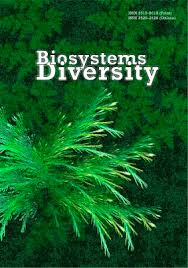Influence of saprophages (Isopoda, Diplopoda) on leaf litter decomposition under different levels of humidification and chemical loading
Influence of saprophages (Isopoda, Diplopoda) on leaf litter decomposition under different levels of humidification and chemical loading
Author(s): A. P. Pokhylenko, O. O. Didur, Y. L. Kulbachko, L. P. Bandura, S. A. ChernykhSubject(s): Agriculture, Energy and Environmental Studies, Sociobiology
Published by: Дніпропетровський національний університет імені Олеся Гончара
Keywords: ecosystem services; millipedes; litter transformation; climate changes; chemical stress; common pill bug;
Summary/Abstract: The paper presents a study about the influence of two saprophage groups (Isopoda, Diplopoda) on leaf litter decomposition under different levels of humidification and chemical stress. Because of their worldwide distribution, we focused on the common pillbug Armadillidium vulgare (Latreille, 1804) (Isopoda, Armadillidiidae), and the common millipede species Rossiulus kessleri (Lohmander, 1927) (Julida, Julidae). The function of environment creation by the given saprophages, as destructors of dead plant matter, supporting such ecosystem services as soil fertility improvement and nutrients’ turnover, is highlighted. To conduct the experiment, the animals were collected manually and using pitfall trapping. In order to bring the experimental conditions closer to the natural, the individuals were not sexed. The maximum consumption of leaf litter by woodlice was recorded in the conditions with adequate moisture (0.5 mL of distilled water per box) and amounted to 2.52 mg/10 individuals per day, which exceeds its consumption with low and increased moisture, respectively, by 1.82 and 1.24 times. As for the effect of interaction, the consumption of maple litter with optimal moisture (4.77 mg/10 individuals per day) was the greatest. The largest absolute difference between broad-leaved tree species in the average weight of leaf litter consumed by woodlice was between maple leaf litter and oak leaf litter, the minimum – between robinia leaf litter and oak leaf litter. According to the results of the obtained data (Diplopoda), it can be stated that there is a statistically significant effect of chemical stress and discrepancy of the average zinc content in the object of study (in Diplopoda and their faecal pellets). We found that the diet provided did not affect the distribution of zinc in Diplopoda under conditions of chemical stress. According to the results of pairwise comparisons, we determined that the zinc content in the Diplopoda clearly differs for control and almost every concentration of zinc sulfate solution – 0.03 and 0.15 g/L, the samples of which do not form a homogeneous group. The species composition, abundance and distribution in space of soil invertebrates are informative indicators which reflect the ecological state of soils, intensity in development of soil horizons as well as intensity of processes occurring in them.
Journal: Biosystems Diversity
- Issue Year: 28/2020
- Issue No: 4
- Page Range: 384-389
- Page Count: 6
- Language: English

